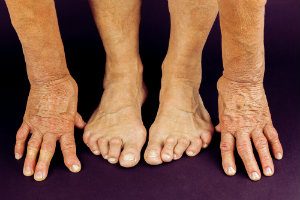Bunionettes
Your feet are remarkably complex structures, with each one consisting of 26 bones, 33 different joints, and over a hundred different muscles, tendons, and ligaments to support your bodyweight and keep you mobile. When bones in the feet and toes start to drift, like in the case of bunions and bunionettes, it disrupts the natural balance and can cause problems. Knowing what a bunionette is and how one can affect you will enable you to know when it is time to seek treatment here at Southern California Foot & Ankle Specialists.
Bunionette Basics – Causes and Symptoms
Many people are generally familiar with bunions – the bony bumps that can develop on the inside edge of the foot, right at the joint where the big toe connects to it. A bunionette is a similar toe deformity, only in this instance it is located on the outer edge of the foot.
 In this particular condition, the little toe starts to drift inwards, towards the other four toes. As this happens, the fifth metatarsal bone in the foot starts angling outwards. This pushes the metatarsophalangeal (MTP) joint out to the side. The MTP joint is where a toe connects to the foot.
In this particular condition, the little toe starts to drift inwards, towards the other four toes. As this happens, the fifth metatarsal bone in the foot starts angling outwards. This pushes the metatarsophalangeal (MTP) joint out to the side. The MTP joint is where a toe connects to the foot.
The reason for this shifting and bunionette (or bunion) development can be attributed to uneven distribution of the physical forces and pressures on the joints and tendons in the feet. Walking, and even just standing, places a lot of weight on the lower limbs. Feet and ankles are durable and can handle a lot, but they are intended to handle them in a particular way. Structural abnormalities can affect this, and an imbalance in force distribution can make the MTP joint become unstable, forcing it out to the side and making the joint tissues harden.
The main symptoms of a bunionette is the bulging bump located on the outside of the foot right at the little toe’s MTP joint. Additional symptoms include:
- Soreness, swelling, and redness around the MTP joint
- Intermittent or persistent pain
- Restricted movement of the little toe
- Thickening of skin (calluses, corns) in the affected area
Treating Bunionettes
It is always our hope that we will be able to treat a bunionette with nonsurgical means, and these can include:
- Splinting or padding and taping – Padding, taping, or splinting relieves stress placed upon your bunionette by positioning the affected toe into a natural position. This can alleviate painful symptoms.
- Shoe inserts – Prescription orthotics are crafted especially for your unique feet and can redistribute pressure more equitably across your foot. This can reduce existing symptoms, but also prevent the condition from worsening.
- Medications – To relieve painful symptoms, we may prescribe medications like naproxen, acetaminophen, ibuprofen or even cortisone injections.
- Icing – After a long day on your feet, icing the area can reduce inflammation and relieve soreness. We will provide you with a recommended icing regimen for optimal effectiveness.
- Footwear changes – Shoes with roomy toe boxes help by keeping pressure off the bunionette, and also decreasing your risk of corns or calluses.
In some cases, unfortunately, conservative treatment is simply not enough. When this is the case, there are several surgical procedures we can perform for you here at Southern California Foot & Ankle Specialists to correct the condition. We will discuss these together and carefully review your options so you can make an informed decision that is best for your health.
There isn’t really much you can do to prevent a bunionette from developing in the first place—since it is the result of inherited foot structure—but your footwear choices can play a role in either exacerbating the condition or keeping it from worsening. You should always choose footwear that does not cramp your toes or cause irritation. Pick shoes featuring wide toe boxes, which means your toes can wiggle, and a little space between the front and your longest toe. Avoid pointy-toed shoes, or at least limit how long you wear them.
Southern California Foot & Ankle Specialists is proud to provide complete foot and ankle care services for Ladera Ranch, CA residents, including effective treatment for bunionettes. Schedule an appointment with our office by calling (949) 364-9255 (WALK), or use our online form to reach us and get the treatment you need.
Contact Us
Ladera Ranch
333 Corporate Dr. Ste 230, Ladera Ranch, CA 92694
Tel: (949) 364-9255 (WALK)
Fax: (949) 364-9250
Office Hours:
Monday - Friday: 9am - 5pm
*(Lunch 12 noon - 1pm)
Orange
2617 E Chapman Ave. Ste 303, Orange, CA 92869
Tel: (714) 639-7993
Fax: (714) 639-0729
Office Hours:
Monday - Friday: 9am - 5pm
*(Lunch 12 noon - 1pm)
